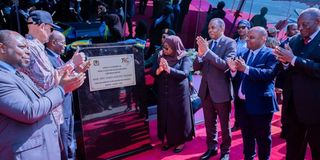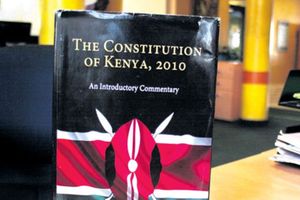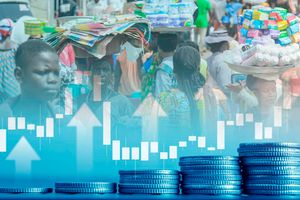
President Samia Suluhu Hassan, on Thursday, August 1, 2024, inaugurated the modern electric-powered Standard Gauge Railway (SGR) train service between Dar es Salaam and Dodoma. PHOTO | STATE HOUSE
An efficient modern railway network is the supreme symbol of economic diplomacy and a well-paved pathway to prosperity and regional integration. That is why African nations are everywhere reviving and modernising their railway network. Tanzania is one of the African countries investing heavily in the railway as a road to shared prosperity nationally and regionally. On August 1, 2024, Tanzania’s sixth President Dr. Samia Suluhu Hassan, officially launched the country’s Standard Gauge Railway (SGR) Project in which it has invested nearly $10 billion. Kenya’s rulers and pundits won’t agree. They lampoon their SGR railway as a ‘road to nowhere’, literally and metaphorically, not to prosperity.
Yet, Tanzanians have embraced their modern railway as a sharp tool of economic diplomacy. They are investing in the modernisation and expansion of their railway network to achieve their national interests and reposition their country as the gateway to East and Central Africa. The result is the longest, most cost-effective, potentially profitable and modern SGR rail system on the African continent covering 2,102 kilometers. After Kenya’s proposed 1,300-kilometer SGR line from Mombasa to Malaba town on the border with Uganda was suddenly stalled at Duka Moja near Naivasha in 2019, the country has only 600 kilometers of SGR railway. This stretch is way below the 1000 kilometers global threshold for profitability.
Moreover, Tanzania’s rulers, unlike their Kenyan counterparts, have bequeathed their nation with one of Africa’s fastest electric-powered SGR, designed to international standards, which has earned two global awards. Tanzania’s SGR line is designed to accommodate speeds of up to 160 kilometers per hour for passenger services and 120 kilometers per hour for freight. The only train on the continent faster than this is Morocco’s Al Boraq, a 323-kilometer high-speed rail service between Casablanca and Tangiers in Morocco, the first of its kind on the African continent opened in 2018. Traveling at 120 Kilometers per hour, Kenya’s dissel-powered SGR railway is out of this league.
Regional integration
Obviously, Tanzania is not new to the railway as a tool of regional integration and pan-Africanism. The Tazara Railway built in the 1970-1975 period and linking the port of Dar es Salaam with Zambia is a testimony to Tanzania’s ‘railway pan-Africanism’.
In addition to developing its SGR railway along the Central Corridor, Tanzania is also modernising its old railway system. Tanzania operates two railway systems, the meter-gauge railway (MGR) alongside the cape gauge railway (CGR) system, covering a total of 3,682 km. In April, the World Bank’s International Development Association (IDA) approval $200 million for the second phase of the Intermodal and Rail Development Project (TIRP-2) to revitalize the country’s meter-gauge railway network as part of the broader USD 300 million TIRP project. Kenya, too, has revitalized meter-gauge railway.
The impact of Tanzania’s SGR has been phenomenal. According to Tanzaniainvest, Tanzania’s rulers expect the project to directly benefit nearly 900,000 of their citizens and approximately 3.5 million others indirectly, roughly 5% of the country’s population. It will significantly enhance safety, climate resilience and operational efficiency; stimulate economic activities in sectors such as industry, agriculture, livestock, tourism, and trade; and increase trade with neighboring landlocked and regional countries. According to President Samia, the SGR will significantly boost the efficiency of Tanzania’s ports, particularly the Dar es Salaam port, which will be capable of handling 17 million tons of cargo annually.
Economic dividends
Apart from the railway’s economic dividends, Tanzania’s political class is using the railway to rekindle nationalism. The Railway embodies the nation’s grand vision and aspirations. Tanzanians have named their stations after their leaders: The Dodoma SGR Station after Samia Suluhu, Morogoro station after Jakaya Kikwete, Dar es Salaam station John Magufuli, Tabora station Ally Hassan Mwinyi, Shinyanga station Abed Karume, Mwanza station Julius Nyerere, and Kigoma station Benjamin Mkapa. Tanzania’s railway network is as much economic as it is a nation-building project. Kenya only stopped at naming 479-kilometer SGR line from Mombasa to Nairobi, completed in May 2017, as Madaraka Express.
Moreover, Tanzania’s leadership has managed to rally national opinion and consensus in around “the SGR as a valuable asset to our economy.” Tanzanians see their SGR project as a “Railway to Prosperity.” This is a contrast to Kenyans who view their SGR as a “railway to nowhere” or a modern day reincarnation of the British-era “Lunatic Express.”
There are reasons galore why Tanzania’s railway appears to be making success compared to Kenya. At the heart of Tanzania’s success in modernization of the railway is continuity of leadership.
Tanzania’s third President, the late Benjamin Mkapa, championed the adoption of East African Railway Master Plan, a proposal for rejuvenating the railways serving Tanzania, Kenya, and Uganda, and building new railways to serve Rwanda and Burundi. The fourth President Jakaya Kikwete conducted feasibility studies; and the fifth, John Pombe Magufuli, initiated construction while the Sixth, Samia, has continued the project under the philosophy of “work continues.”
A broad-based network of partners has enabled Tanzania to secure funding and technical support from diverse donors, avoiding Western propaganda booby-trap around the ‘debt-trap diplomacy’ associated with China. South Korea has supplied Tanzania with the state-of-the-art electric trains. Turkish and Portuguese companies have been involved in construction work. In And the African Development Bank (AfDB) funding for the construction of 411 kilometers of Tabora-Kigoma SGR line and the 156-kilometers Uvinza- Malagarasi rail.
Tanzania’s deeply nationalistic political culture has also shielded the SGR project from parochial ethnic politics that framed Kenya’s SGR during the 2017 and 2022 elections. Finally, Tanzania’s leadership has minimized the kind of allegations of corruption that bedeviled the Kenyan SGR project. Agencies have moved in fast to fight corruption associated with ticketing.
Professor Peter Kagwanja is the Chief Executive at the Africa Policy Institute (API), Adjunct Professor University of Nairobi & Visiting Scholar at the National Defence University-Kenya













